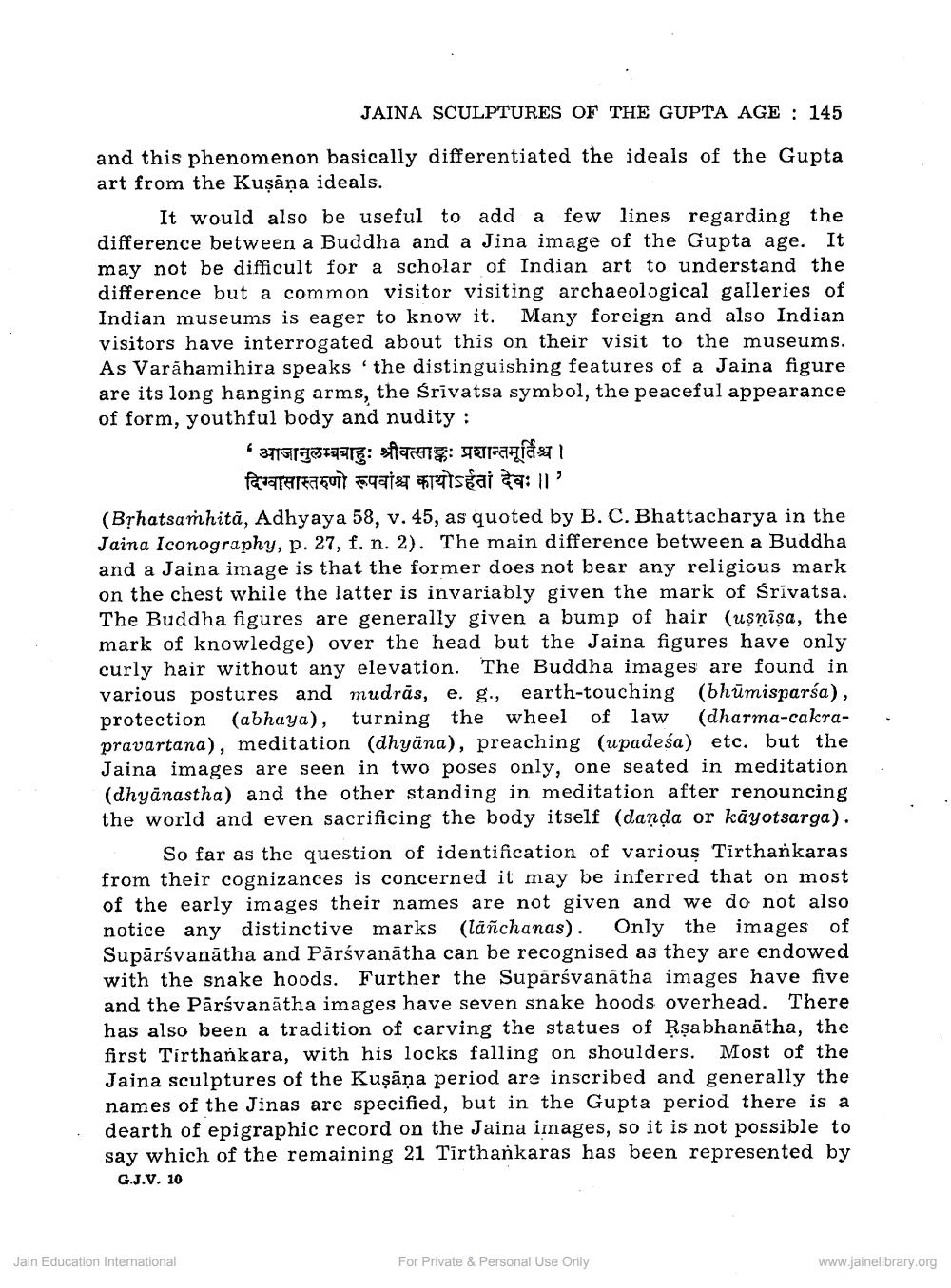Book Title: Jaina Sculptures of the Gupta Age in the State Museum Lucknow Author(s): R C Sharma Publisher: Z_Mahavir_Jain_Vidyalay_Suvarna_Mahotsav_Granth_Part_1_012002.pdf and Mahavir_Jain_Vidyalay_Suvarna_ View full book textPage 7
________________ JAINA SCULPTURES OF THE GUPTA AGE : 145 and this phenomenon basically differentiated the ideals of the Gupta art from the Kuşāņa ideals. It would also be useful to add a few lines regarding the difference between a Buddha and a Jina image of the Gupta age. It may not be difficult for a scholar of Indian art to understand the difference but a common visitor visiting archaeological galleries of Indian museums is eager to know it. Many foreign and also Indian visitors have interrogated about this on their visit to the museums. As Varāhamihira speaks the distinguishing features of a Jaina figure are its long hanging arms, the Śrivatsa symbol, the peaceful appearance of form, youthful body and nudity : 'आजानुलम्बबाहुः श्रीवत्साङ्कः प्रशान्तमूर्तिश्च । दिग्वासास्तरुणो रूपवांश्च कायोऽर्हतां देवः॥' (Bịhatsaṁhita, Adhyaya 58, v. 45, as quoted by B. C. Bhattacharya in the Jaina Iconography, p. 27, f. n. 2). The main difference between a Buddha and a Jaina image is that the former does not bear any religious mark on the chest while the latter is invariably given the mark of srivatsa. The Buddha figures are generally given a bump of hair (uşnişa, the mark of knowledge) over the head but the Jaina figures have only curly hair without any elevation. The Buddha images are found in various postures and mudrās, e. g., earth-touching (bhūmisparśa), protection (abhuya), turning the wheel of law (dharma-cakrapravartana), meditation (dhyāna), preaching (upadeśa) etc. but the Jaina images are seen in two poses only, one seated in meditation (dhyānastha) and the other standing in meditation after renouncing the world and even sacrificing the body itself (danda or kāyotsarga). So far as the question of identification of various Tirthankaras from their cognizances is concerned it may be inferred that on most of the early images their names are not given and we do not also notice any distinctive marks (lañchanas). Only the images of Supārsvanātha and Pārsvanātha can be recognised as they are endowed with the snake hoods. Further the Supārsvanātha images have five and the Pārsvanātha images have seven snake hoods overhead. There has also been a tradition of carving the statues of Rşabhanātha, the first Tirthankara, with his locks falling on shoulders. Most of the Jaina sculptures of the Kuşāņa period are inscribed and generally the names of the Jinas are specified, but in the Gupta period there is a dearth of epigraphic record on the Jaina images, so it is not possible to say which of the remaining 21 Tirthankaras has been represented by G.J.V. 10 Jain Education International For Private & Personal Use Orily www.jainelibrary.orgPage Navigation
1 ... 5 6 7 8 9 10 11 12 13
